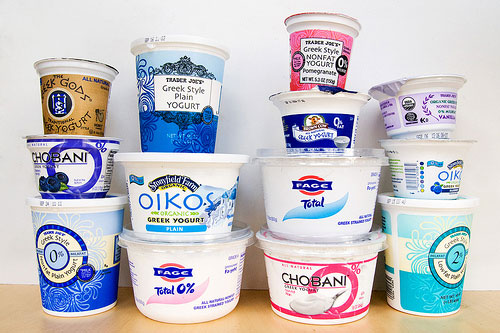Yogurt Power
In 2007, only 1% of American yogurt purchases were of the Greek yogurt variety. Today, according to TIME, that number has risen to 35% — that’s $1.6 billion spent annually on items like the ones pictured above. Greek yogurt is strained, leaving behind a consistency closer to cheese than that of typical yogurt — and, as a result (and a likely driver of its popularity), has less sugar and a higher protein content. But this straining comes at a price — a leftover that isn’t easy to dispose of. One idea? Turn it into power.
The process to create Greek yogurt is pretty straightforward, as the yogurt is passed through cheesecloth to strain out excess whey. The leave-behind is acid whey, which, per CNN, “contains lactose, lactic acid from the fermentation and a small amount of dairy proteins and milk salts like calcium.” And there’s a lot of it — it takes about three pounds of milk to make a pound of Greek yogurt, so there’s a sizable amount of acid whey left over at the end. In small amounts, as CNN notes, it’s perfectly fine to eat the stuff. But the operative words are “in small amounts,” as we have much more than that left over. You can’t just dump the whey; as Modern Farmer asserts, “whey decomposition is toxic to the natural environment, robbing oxygen from streams and rivers.” So we have to find something else do to with what Modern Farmer describes as “thin, runny waste.” (The Modern Farmer article suggests that this is a massive environmental problem, but other sources call that article alarmist.)
One of the solutions to this whey wasteland? A contraption known as an “anaerobic digester,” a 1.5 million gallon tank of whey and manure. (An example of one from a wastewater plant near Albany, New York, can be seen here.) The manure contains bacteria that eats on the lactose in the whey, producing methane gas as a byproduct. (The process also makes the manure smell less awful, which according to Modern Farmer, is why the digester was built in the first place.) The digester is designed to collect the methane, which can be used to power the farm. And while most of the excess whey from yogurt goes into feed or fertilizer, the tiny amount which goes into the digester has significant value. Per the AP, the 1,000 killowatt-hour generators powered by digester-provided methane save farms nearly a million dollars in energy costs.
Bonus fact: Little Miss Muffet, as we all know, sat on a tuffet, eating her curds and whey. In this case, “curds and whey” are cottage cheese — the white clumps are the curds, and the whey is the white watery liquid enveloping the curds. Cottage cheese is a byproduct in its own right; the leftover milk from making butter was allowed to curdle (creating the curds) while sitting in the whey also strained from the butter.
From the Archives: Embargo Elixir: How a popular drink made of the “leftover of the leftovers” came to be.
Related: “How to Make Homemade Yogurt” by Liz Vidal. 4.1 stars on 27 reviews.
Yogurt image via Serious Eats.

